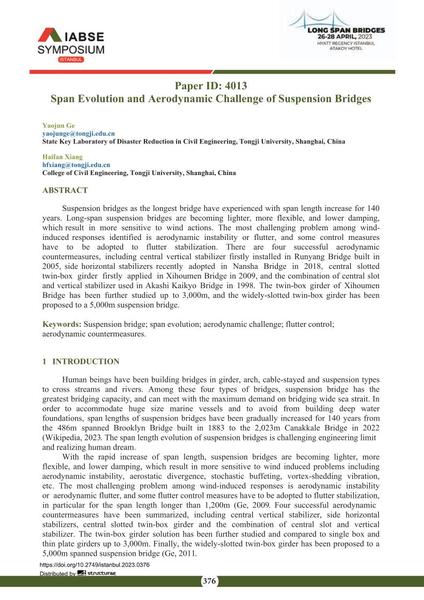Span Evolution and Aerodynamic Challenge of Suspension Bridges

|
|
|||||||||||
Bibliographic Details
| Author(s): |
Yaojun Ge
(State Key Laboratory of Disaster Reduction in Civil Engineering, Tongji University, Shanghai, China)
Haifan Xiang (College of Civil Engineering, Tongji University, Shanghai, China) |
||||
|---|---|---|---|---|---|
| Medium: | conference paper | ||||
| Language(s): | English | ||||
| Conference: | IABSE Symposium: Long Span Bridges, Istanbul, Turkey, 26-28 April 2023 | ||||
| Published in: | IABSE Symposium Istanbul 2023 | ||||
|
|||||
| Page(s): | 376-383 | ||||
| Total no. of pages: | 8 | ||||
| Year: | 2023 | ||||
| DOI: | 10.2749/istanbul.2023.0376 | ||||
| Abstract: |
Suspension bridges as the longest bridge have experienced with span length increase for 140 years. Long-span suspension bridges are becoming lighter, more flexible, and lower damping, which result in more sensitive to wind actions. The most challenging problem among wind-induced responses identified is aerodynamic instability or flutter, and some control measures have to be adopted to flutter stabilization. There are four successful aerodynamic countermeasures, including central vertical stabilizer firstly installed in Runyang Bridge built in 2005, side horizontal stabilizers recently adopted in Nansha Bridge in 2018, central slotted twin-box girder firstly applied in Xihoumen Bridge in 2009, and the combination of central slot and vertical stabilizer used in Akashi Kaikyo Bridge in 1998. The twin-box girder of Xihoumen Bridge has been further studied up to 3,000m, and the widely-slotted twin-box girder has been proposed to a 5,000m suspension bridge. |
||||
| Keywords: |
suspension bridge aerodynamic challenge aerodynamic countermeasures span evolution flutter control
|
||||

